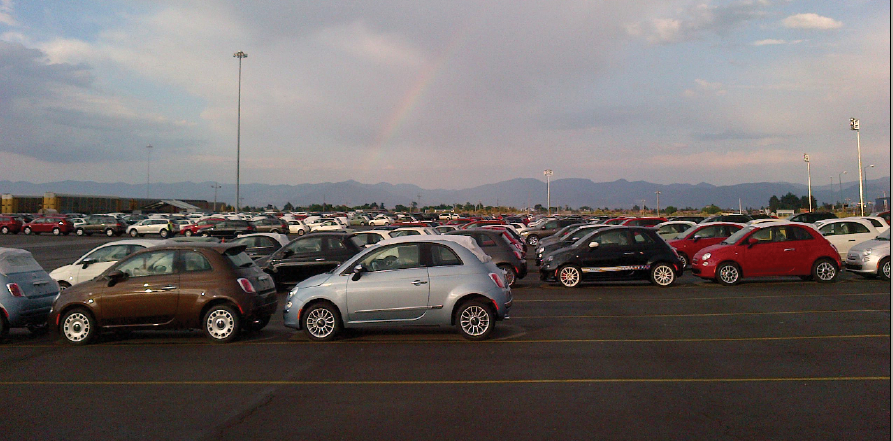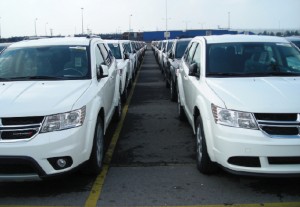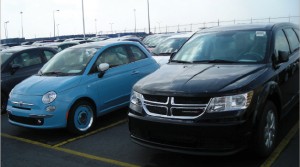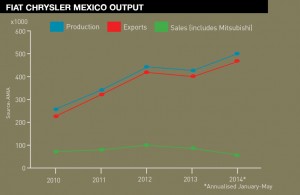Fiat Chrysler's automotive melting pot
 *This article is part of a special focus on Mexico. For other features related to finished vehicle logistics in Mexico click here. For features on the automotive supply chain in Mexico click here.
*This article is part of a special focus on Mexico. For other features related to finished vehicle logistics in Mexico click here. For features on the automotive supply chain in Mexico click here.
Mercedes Figueroa (below) has taken over Fiat Chrysler’s logistics at a time of supply chain and sales integration. In the last feature in our special Mexico coverage, she explains how she thinks the next step is more sharing across the industry
Global integration has been a major focus across Fiat and Chrysler since the Turin-based group gained control of the latter while it was in bankruptcy in 2009. Five years on, the combination continues apace, not only in finances, but especially in the mix of products, manufacturing, supply chains and distribution. The brands are increasingly transnational, whether it is Jeep architecture finding its way to Maserati vehicles; European vans mixing with Ram; Alfa Romeo platforms underpinning Chrysler models; or indeed Italian, Chinese and Brazilian factories set to build Jeeps. The very structure of the combined company – soon to be registered in the Netherlands, headquartered in London, with a stock listing in New York and manufacturing flung across the globe – increasingly defies the traditional notion of an Italian Fiat and an American Chrysler.

Mexico was an early melting pot for the brands. Soon after the merger, the company retooled its plant in Toluca, near Mexico City, and in 2011 it started building the Fiat 500 and Fiat Freemont (which is the Dodge Journey in the US). The Ram ProMaster van, based on the Fiat Ducato, was later brought to Saltillo, further north, at a new plant next to the carmaker’s existing truck and engine factories.
Likewise, the Mexican operations are linked closely to Chrysler’s manufacturing and markets in the US and Canada. Saltillo supplies engines for vehicles like the Dodge Charger, Chrysler 300, Town & Country and Jeep Grand Cherokee. According to AMIA, the Mexican carmaker’s association, 71% of the company’s 402,000 car and truck exports last year went to the US and Canada, while vehicles also moved to Asia, Europe and South America.
Mercedes Figueroa is herself a good representative of Fiat Chrysler’s transnational composition and certainly of its North American integration. A native of Mexico City, she started in finance at Chrysler’s truck assembly here in 1997 before moving shortly afterwards into logistics. She was later sent to the US on an expat assignment as a liaison for Chrysler’s Mexican plants, where she ended up staying and taking on permanent roles in international operations and finance. She would go on to work across launches at a number of plants including Jefferson North in Detroit; Brampton in Ontario, Canada; and in Mexico. More recently she worked in international logistics, responsible for moving parts between the Fiat Group’s different poles and brands, including European suppliers for the ProMaster in Saltillo.
Earlier this year, Figueroa took over as head of logistics and customs at Fiat Chrysler Mexico – this time as an ‘expat’ in her home country, sent from corporate offices in Michigan. With her NAFTA and international logistics experience, as well as her dual-national identity, Figueroa very much transcends the US-Mexico border in both career and person.
Ready for the future
That experience and outlook will be important for the next stage of the company’s growth in Mexico. The integration of Fiat and Chrysler is pushing considerably more freight and vehicle flows within NAFTA and beyond. The next generation of models at Toluca, as yet unannounced, could change the carmaker’s supply chain and logistics even further, with both short and long-term impacts for logistics providers.
Mercedes Figueroa started her role as head of logistics and customs in Mexico this past February. She has responsibility for the movement of all inbound parts and outbound vehicles within Mexico, including up to the US border crossing or port of departure, and imports from the border and ports to plants and dealers. She is also responsible for damage prevention, customs clearance for parts and vehicles, as well as delivery programming and scheduling for the plants. Her ‘expat’ assignment is scheduled to last three years.
This role is not all about logistics for Figueroa. She is working together with a number of other women at Chrysler, including Lorena Vallejo, corporate communications manager, to launch the first women’s forum for Chrysler in Mexico. The forum will include events and programmes designed to help connect female executives across the company, with a focus on issues including career development and talent retention.
“If we have new models in Toluca, we will have to work very closely with our suppliers and providers to prepare for some downtime,” she says. “We don’t expect any penalties on either side however, as at the end they will catch up with the launch and new volumes.”
Figueroa has an important job in managing the company’s supply chain and vehicle distribution at a time when both Fiat Chrysler and the Mexican industry are anticipating significant growth. By now, the challenges facing vehicle exports – which dominate volume out of Mexico – have been well documented in these reports and elsewhere. Figueroa herself jokes that her top three problems for outbound logistics are “rail shortages, rail shortages and rail shortages”.
For good measure, Figueroa adds that she is worried about port infrastructure, especially with the expectation that there will be more Fiat Chrysler exports and imports.
Figueroa may technically be working in Mexico as an expat, but her warm laugh and easy conversation remind you that she is still a native, confident and comfortable with confronting the issues of the day here. If railway executives serving Mexico have felt under fire from carmakers lately, Figueroa appears more inclined to sit down and listen to them. She understands that she will have to share more information and plans if she wants something in return. “We have regular collaboration meetings with the railways,” she says. “If we can show them that we are going to have some secure, consistent demand, that means they will have a secure flow from our plants, and can help them to plan. Hopefully, it also means that we’ll gain

some kind of preference.”
Network by land and sea
Part of Chrysler’s integration in North America includes a highly centralised logistics organisation, with the carmaker’s Auburn Hills-based team primarily responsible for inbound and outbound network engineering across the US, Canada and Mexico. For outbound, the carmaker outsources to Ryder mainly for routing and network design.
Fiat Chrysler also works with a number of other operators in vehicle logistics in Mexico, including yard management and handling with Amports, CSI, Vascor, Carlogistics and SSA. Its principal road haulier is Grupo Tracomex, which is owned directly by an association of Chrysler dealers.
From Mexico, Fiat Chrysler generally ships 100% of its US and Canada-bound vehicles by rail. Of those movements, around 90% move into the US at Eagle Pass, as there is a Ferromex line close its Chrysler’s plants in Saltillo. Most of the rest of the vehicles also move by Ferromex through El Paso, however all Fiat 500 and Dodge Journeys enter the US at Laredo on a KCSM line.
Chrysler is one of the few light vehicle makers in Mexico that also uses road for export north of the border. The Ram ProMaster van is a large, tall vehicle that would have required a specialised wagon design and construction to move by rail. Figueroa says she understands why the railways were reluctant to invest in such equipment without enough volume from other manufacturers. The vans move by road from Saltillo, are reloaded at the border to change truck and drivers, before onward distribution by the road in the US. “It works well, despite there being timing issues with exchanging the equipment,” she says.
According to AMIA, around 115,000 Fiat Chrysler exports from Mexico went beyond North America last year. About 30% of exports moved by sea were sent via Lázaro Cárdenas, and 70% from Veracruz, says Figueroa.
"If we have new models in Toluca, we will have to work very closely with our suppliers and providers to prepare for some downtime. We don’t expect any penalties on either side however, as at the end they will catch up with the launch and new volumes" - Mercedes Figueroa, Fiat Chrysler
The import network is similar to the export. Fiat Chrysler builds fewer than 25% of the cars it sells in Mexico in the country, thus bringing in around 80,000 vehicles. For those that do not come back to Mexico on a return rail journey from the US, there is roughly the inverse split for imports: 70% of imports through Lázaro and 30% through Veracruz.

Chrysler also has distribution yards and outfit centres for accessory installations close to its plants in Toluca and Saltillo, both of which are managed by logistics providers.
Figueroa says the network is generally reliable and consistent, with promised delivery times more than 95% accurate. Along with all other major volume players this year, however, the winter disturbances that paralysed the North American rail network have impacted Fiat Chrysler. While the company is ahead of its target deliveries and lead times for imports and distribution within Mexico, it has been more difficult to get vehicles out of Mexico with rail wagons stuck up north. “We started with a spot vessel to Baltimore to relieve our backlog,” Figueroa says. “In the end we have sent five vessels from Altamira and Veracruz.”
Even with these delays and the fear that the rail sector won’t keep up with the industry’s output, Figueroa still favours using rail over introducing short-sea services more regularly. “Overall, we see short-sea shipping as more expensive,” she says. “The frequencies are limited, with sometimes just one sailing per month compared to a daily service for rail.”
Nevertheless, she admits that if the rail situation doesn’t change, there are likely be more movements by ocean across the industry. For this to be more interesting to Chrysler, there would need to be significant increases in shuttle services as well as investment in terminal capacity at ports. “Veracruz and Lázaro Cardenas already have limitations. A big growth in either would cause delays,” she says.

Working together at home and away
Domestic sales in Mexico for Fiat Chrysler were just shy of 100,000 units. The company is also responsible for distributing Mitsubishi in the country. Until recently, it also managed Hyundai movements, although the Korean carmaker has now setup its own network.
For the domestic market, Chrysler uses trucking for all vehicles. As described earlier, the company’s dealer groups own Tracomex, whose core business is transporting Chryslers, managing storage yards on behalf of dealers, and carrying out some technical work, such as homologation for imports. While Tracomex has several other customers, it moves 100% of Chryslers for the domestic market. Fiat vehicles, however, have a different service provider, which allows the company to at least benchmark and measure competition.
In Mexico, Fiat Chrysler’s logistics controls vehicle movements until they are released to a Tracomex carrier or yard, after which point the carrier and dealer take responsibility for routing and distribution, as well as accessory installation where necessary (which they may outsource to other logistics providers). While it does mean the carmaker loses a degree of control in its order fulfilment and transport rates, having a dealer-owned carrier also tends to be very customer focused, says Figueroa.
“The positive thing about the situation is that Tracomex really works for the dealer, which means that its employees understand that whatever they do really has an impact on the final customer,” she says.
Figueroa adds that Fiat Chrysler is working to make sure that Tracomex is using the most optimal equipment and maintaining high standards in its business. For example, she recently learned about other carriers that use different size trucks for distribution, including smaller ones for urban delivery and longer trucks for long-haul movements. “We have had meetings with Tracomex to discuss as a partner how they might be able to explore other options and opportunities so that in the end we all can win,” she says. The company has so far been open to new ideas, she adds.

Figueroa believes it will be important for Fiat Chrysler to work together with all of its carriers and logistics service providers if it is going to prepare for the rising demand across the sector, but she also thinks that carmakers are going to have to go further than that, including working together too. Figueroa already has had experience with such collaboration in her prior roles, including helping to implement shared crossdocks in the US between Chrysler and General Motors. Now she believes there is further opportunity among OEMs for sharing outbound loads for rail, yard management and road for Mexico.
“As OEMs, we cannot control the investments in infrastructure by ports or what the railways ultimately do, but we do have control over collaborating with each other by rail and haulaway,” she says. “We are already exploring options with another OEM on haulaway moves, who has expressed interest.”
Figueroa says Tracomex has already said it would be willing to share its capacity, as has the other OEM’s carrier. “They are open to saving money,” she says.
Such a move could be yet a further step in bringing together the network both in Mexico and North America. With so many shared providers, routes and services moving through the same interchanges and border points, it only makes sense for carmakers to find ways of physically moving together, says Figueroa. “We hope that if we start working together, then perhaps other OEMs will also follow or join us.”





